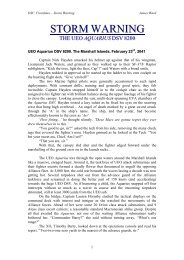CROSSFIRE - Atlantis DSV - New Cape Quest
CROSSFIRE - Atlantis DSV - New Cape Quest
CROSSFIRE - Atlantis DSV - New Cape Quest
Create successful ePaper yourself
Turn your PDF publications into a flip-book with our unique Google optimized e-Paper software.
and had quickly headed for the base transit hub which eventually led him to the main gantry<br />
that served as the direct accessway to <strong>Atlantis</strong>. When the elevator doors finally opened at<br />
the bottom of that facility, the view that met him was nothing less than astonishing.<br />
The observation tower at the top of the gantry looked out directly over the ruined hull<br />
of the <strong>DSV</strong>, its six-inch-thick view ports offering an expansive view of the upper most<br />
reconstruction works. For several long minutes, he had simply stood at the portal and<br />
watched in silence, studying the work that had already been done to the ship. Vast sections<br />
of the outer hull‟s plate work that had been destroyed by the detonation of the subduction<br />
warheads had been stripped away, and huge clamps and feeder tanks were hooked in to the<br />
thick, flesh-like bioskin which had been cut back and pulled away. Even under the<br />
illumination of the twelve titanic light towers above, it was hard to make out much in the way<br />
of detail through the gloom.<br />
The entire operation felt surreally like a giant operating theatre, the patient covered in<br />
frames, lights, clamps and coverings that concealed the rest of her towering flanks. Robotic<br />
drones worked efficiently through the mess of damaged and rebuilt support frames, loading<br />
and unloading cargo pallets from a constant and steady stream of DSRVs that hovered<br />
around the site. Most impressive of all was the single, massive crane that had been erected<br />
over the ship‟s shelter decks, supported by a temporary and ungainly set of hefty<br />
construction scaffolds which were used to hoist and manoeuvre the larger sections of hull<br />
that were being replaced.<br />
Ainsley moved on, slowly strolling through the boarding tunnel that adjoined with the<br />
ship somewhere forward of the main hangar bays, all the while reflecting on those dark<br />
moments that had reduced the great ship to this.<br />
...He stopped in surprise as he looked around at where he then stood. Plainly, it was<br />
one of the starboard cross-corridors on <strong>Atlantis</strong>, but he had never even remembered walking<br />
through an airlock. It took him several moments to realise, as he turned and looked back up<br />
his path, that the gantry had been physically built in to the ship‟s internal decks, and the only<br />
reason he didn‟t even notice was that the deck he now stood on had been completely rebuilt.<br />
He ran his hand across the cool metal of the bulkhead as he read the frame code: D-<br />
Deck, frame seven, starboard cross-junction. There was a sobering moment of silence as he<br />
paused in his walk and drew a breath, smelling the stale air. It smelt rank of oils, fuel and<br />
industrial lubricants. The air was still, too, the long and dim passages that extended in to the<br />
bowels of the ship before him ringing dully of the distant sound of generators, twisting metal<br />
and tools.<br />
Ainsley reminded himself sorely that five hundred and eighty three people had died in<br />
those halls. Many had perished instantly in the moment that the Alliance missiles struck the<br />
ship, ripping open her hull like claws through an animal. Others had died in the fires that had<br />
washed through the corridor he now stood in, and many more like it. He didn‟t have to walk<br />
far before he rounded a corner and was stopped by a transverse bulkhead, the corridor<br />
abruptly ending at a tightly sealed pressure door. Ainsley had no way of knowing what was<br />
behind that bulkhead, whether it was simply an unsecured and damaged section of the ship,<br />
or a complete hull breach with seven thousand pounds per square inch of pressure behind it.<br />
The stairwell next to that bulkhead, however, seemed intact.<br />
The flight deck was traditionally the busiest part of any warship, be it a surface<br />
aircraft carrier like those that for so long defined traditional naval powers, or modern<br />
subcarriers like <strong>Atlantis</strong> or Commonwealth. No matter the time of day or night, ground crews<br />
would work around the clock to keep fighters maintained, armed, fuelled and returned to<br />
flight lines for deployments that could be ordered with as little as five minute‟s notice... or<br />
even less.<br />
Few things, then, were as genuinely spooky as an abandoned flight deck hangar,<br />
and absolutely none were as large as the one which sat in the bowels of <strong>Atlantis</strong>. The flight<br />
deck of the <strong>DSV</strong> was so massive that one could probably fill it with grandstands and still<br />
have an area large enough to play a game of professional football. Two hundred meters<br />
long, eighty meters wide, the operational decks alone spanned six decks, and that didn‟t<br />
- 223 -





